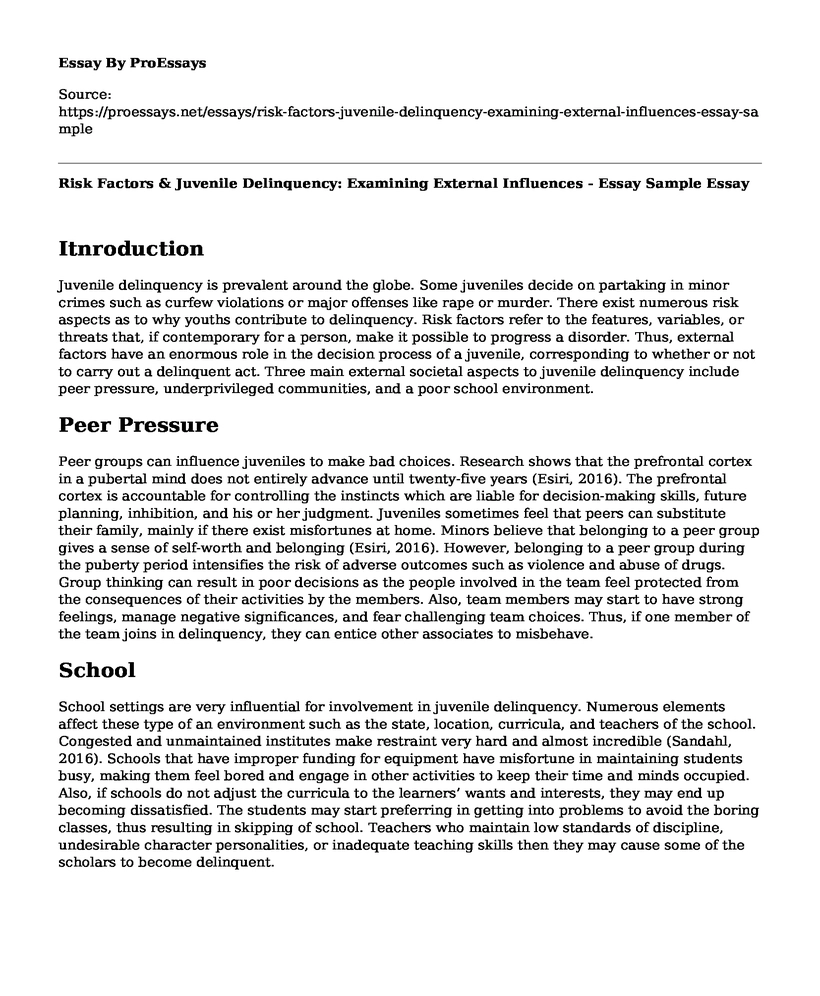Itnroduction
Juvenile delinquency is prevalent around the globe. Some juveniles decide on partaking in minor crimes such as curfew violations or major offenses like rape or murder. There exist numerous risk aspects as to why youths contribute to delinquency. Risk factors refer to the features, variables, or threats that, if contemporary for a person, make it possible to progress a disorder. Thus, external factors have an enormous role in the decision process of a juvenile, corresponding to whether or not to carry out a delinquent act. Three main external societal aspects to juvenile delinquency include peer pressure, underprivileged communities, and a poor school environment.
Peer Pressure
Peer groups can influence juveniles to make bad choices. Research shows that the prefrontal cortex in a pubertal mind does not entirely advance until twenty-five years (Esiri, 2016). The prefrontal cortex is accountable for controlling the instincts which are liable for decision-making skills, future planning, inhibition, and his or her judgment. Juveniles sometimes feel that peers can substitute their family, mainly if there exist misfortunes at home. Minors believe that belonging to a peer group gives a sense of self-worth and belonging (Esiri, 2016). However, belonging to a peer group during the puberty period intensifies the risk of adverse outcomes such as violence and abuse of drugs. Group thinking can result in poor decisions as the people involved in the team feel protected from the consequences of their activities by the members. Also, team members may start to have strong feelings, manage negative significances, and fear challenging team choices. Thus, if one member of the team joins in delinquency, they can entice other associates to misbehave.
School
School settings are very influential for involvement in juvenile delinquency. Numerous elements affect these type of an environment such as the state, location, curricula, and teachers of the school. Congested and unmaintained institutes make restraint very hard and almost incredible (Sandahl, 2016). Schools that have improper funding for equipment have misfortune in maintaining students busy, making them feel bored and engage in other activities to keep their time and minds occupied. Also, if schools do not adjust the curricula to the learners’ wants and interests, they may end up becoming dissatisfied. The students may start preferring in getting into problems to avoid the boring classes, thus resulting in skipping of school. Teachers who maintain low standards of discipline, undesirable character personalities, or inadequate teaching skills then they may cause some of the scholars to become delinquent.
Community
Underprivileged communities provide juveniles with illegal markets, gangs, violence, drug supply networks, and wrong role models. The population in which a kid stays makes them decide the available opportunities, which sometimes may lead to adverse outcomes (O’Brien et al., 2013). Societies that have accessible transport and several job opportunities enable parents to maintain steady work and keep their children away from poverty. Though, in communities with inadequate employment, chances lead to more significant incidents of poverty, crime, and unemployment. Regularly in these societies, there are numerous opportunities, such as criminal actions, as a source of income. If the children observe many people take part in illegal activities, they might perceive unlawful performances as acceptable in the community. Thus, societies are substantially providing and encouraging critical moments for adolescents to act and contribute to crime.
Conclusion
There are various reasons why juveniles agree to take part in delinquency. Educating the underprivileged communities may help in dissolving the abuse of drugs and delinquencies on the streets. Also, there should exist a training program for the children on the impacts of peer pressure, which might lead to adverse outcomes such as violence. Thus, unstable communities, schools, and peer groups are some of the external societal aspects that may influence juveniles to partake in delinquent behavior.
References
Esiri, M. O. (2016). The influence of peer pressure on criminal behavior. Journal of Humanities and Social Science, 21(1), 08-14. https://pdfs.semanticscholar.org/e6c3/1daaa258e18bddf07f5728a13b8a889e10eb.pdf
O’Brien, K., Daffern, M., Chu, C. M., & Thomas, S. D. (2013). Youth gang affiliation, violence, and criminal activities: A review of motivational, risk, and protective factors. Aggression and violent behavior, 18(4), 417-425. https://doi.org/10.1016/j.avb.2013.05.001
Sandahl, J. (2016). School climate and delinquency–on the significance of the perceived social and learning environment in a school for refraining from offending. Journal of Scandinavian Studies in Criminology and Crime Prevention, 17(2), 110-130. https://www.tandfonline.com/doi/full/10.1080/14043858.2016.1260335
Cite this page
Risk Factors & Juvenile Delinquency: Examining External Influences - Essay Sample. (2023, Aug 13). Retrieved from https://proessays.net/essays/risk-factors-juvenile-delinquency-examining-external-influences-essay-sample
If you are the original author of this essay and no longer wish to have it published on the ProEssays website, please click below to request its removal:
- Crimes Among Priests and Clericals Essay Example
- Essay Sample on Segregation and Activism
- Legalization of Marijuana Production for Individual Use Essay Example
- Michael Brown Shooting Case Study
- Criminal Justice System Annotated Bibliography: Building Trust, Reducing Fear
- Unjust Prejudices at Work: A Violation of Human Rights - Research Paper
- Defendant's Reckless Act Proportional to Intentional Murder: States' Laws on Dangerous Dogs - Essay Sample







